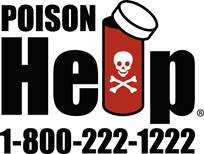Poisoning Prevention
 Every day, over 300 children in the United States ages 0 to 19 are treated in an emergency department, and two children die, as a result of being poisoned. It’s not just chemicals in your home marked with clear warning labels that can be dangerous to children.
Every day, over 300 children in the United States ages 0 to 19 are treated in an emergency department, and two children die, as a result of being poisoned. It’s not just chemicals in your home marked with clear warning labels that can be dangerous to children.
Everyday items in your home, such as household cleaners and medicines, can be poisonous to children as well. Medication dosing mistakes and unsupervised ingestions are common ways that children are poisoned. Active, curious children will often investigate—and sometimes try to eat or drink—anything that they can get into.
Thankfully, there are ways you can help poison-proof your home and protect the children you love.
Key Prevention Tips
Lock them up and away.
Keep medicines and toxic products, such cleaning solutions and detergent pods, in their original packaging where children can’t see or get them.
Know the number.
Put the nationwide poison control center phone number, 1-800-222-1222, on or near every telephone in your home and program it into your cell phone. Call the poison control center if you think a child has been poisoned but they are awake and alert; they can be reached 24 hours a day, seven days a week. Call 911 if you have a poison emergency and your child has collapsed or is not breathing.
Read the label.
Follow label directions carefully and read all warnings when giving medicines to children.
Don’t keep it if you don’t need it.
Safely dispose of unused, unneeded, or expired prescription drugs and over the counter drugs, vitamins, and supplements. To dispose of medicines, mix them with coffee grounds or kitty litter and throw them away. You can also turn them in at a local take-back program or during National Drug Take-Back events.
Additional Resources
- UpandAway.org
- PoisonHelp
- American Association of Poison Control Centers, Inc
- Prevent Child Injury
Available toolkits include laundry detergent packets, liquid nicotine, and medication safety.
- Page last reviewed: April 28, 2016
- Page last updated: April 28, 2016
- Content source:
- Centers for Disease Control and Prevention,
- National Center for Injury Prevention and Control,
- Division of Unintentional Injury Prevention


 ShareCompartir
ShareCompartir